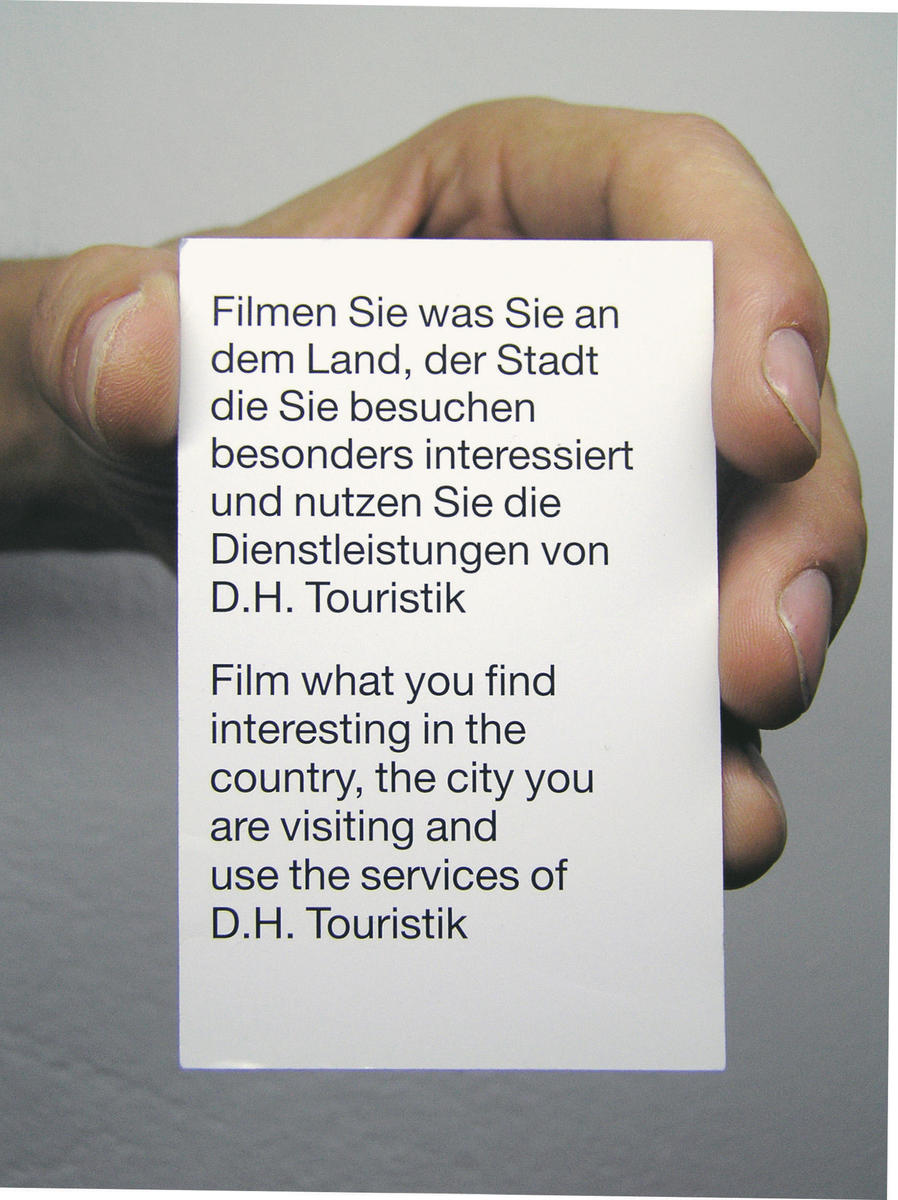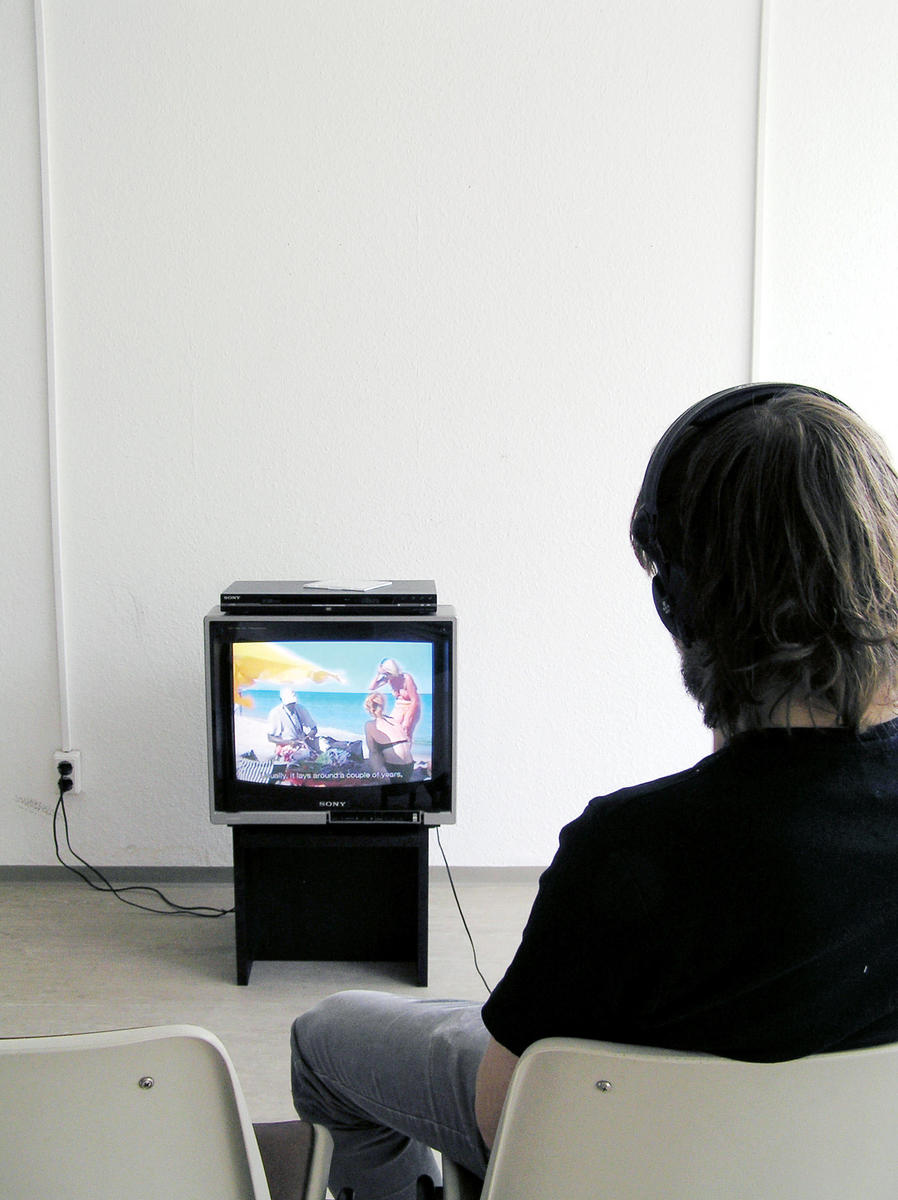
In the summer of 2004, the artist Dirk Herzog installed a makeshift travel agency in Berlin’s Kreuzberg neighborhood. In the project, titled That’s exactly as I imagined it, Herzog offered to edit his customers’ holiday footage for them. Get a trained professional to rework your digicam material, and the amateur tapes become cutting-edge art cinema you can flaunt to friends and family. So the tourist guidance here doesn’t come before or during the trip, but afterwards. The expert fine-tunes your pleasures of retrospection rather than the practicalities of your voyage. And as your trusty mnemonic sherpa, the artist-as-service-worker will not test or challenge you by opening dizzying gateways to intercultural communication; he knows that when people travel, the last thing they want is to see something new. Experiments in novelty aside, Herzog’s project has the merit of showing both what the tourists saw and what the artist thinks they’d like to remember having seen. It documents the tensions between mainstream consumer expectations, highbrow values and cultural management aspirations–tensions that are hard to trace in actual tourist guidebooks.
Tourism is still an overwhelmingly First World to First World affair, with faraway beaches and jungle treks second in popularity to the Louvre and the Empire State Building. But even when it is indeed a case of traveling to places where you’d expect your waiter to wear bangles and flip flops, the genuinely outlandish is not necessarily being sought. Dirk Herzog aside, travelographers from the precautious John Urry (The Tourist Gaze) to the outraged Dean Maccannell (Empty Meeting Grounds: The Tourist Papers) to the apologetic Jim Butcher (The Moralization of Tourism) seem to agree on the recent rise of something akin to “post-tourists”: tourists with a healthy sense of self-irony. Such tourists know very well that, at the end of the day, they’re spending hard-earned money on little more than waddling for hours through airport security, listening to museum guides peddling nationalistic half-truths in silly accents, getting into the same old arguments with their partners — arguments made more scathing by sunburn and indigestion — and watching half-naked bongo players who spend their time off listening to Sean Paul. The post-tourist guidebook has changed accordingly.
In an “exactly how I imagined it and that’s fine with me” market, a guidebook becomes a means of damage control, minimizing the harm to your stomach, your wallet and your self-respect. Far from a pocket-sized portal to an unknown civilization, it is, on the contrary, a yardstick of common knowledge. It will tell you what you’re expected to know. And it will help you play Indiana Jones, going that extra mile, hiking that extra trail, tasting that extra delicacy, and bargaining for that extra dollar–and then correcting your guidebook from the comfort of your laptop. (Dear feedback @letsgoindia.com: contrary to what you claim, the Calcutta bus terminal does NOT have a 24-hour drug store — it’s closed from 4 to 6 am.) Or you can suavely mock the mistakes in the phrasebook section. (See: the inference in Lonely Planet Iran that, in Farsi, “I’m a vegetarian” is “man sabzi kharam,” which is better translated as “I am herb donkey.”) As Lonely Planet founder Tony Wheeler himself has pointed out, many readers go a step further, using his books as guidelines on places to avoid. Rarely has distinction come so easily.
Early travel guides also sought to engineer the travel experience: John Murray’s 1854 Handbook for Travelers in Greece points out the best ways to resuscitate that Homerian je ne sais quoi in every nook and cranny of the country. “In the language and manners of every Greek sailor and peasant,” says the preface, “the classical scholar will constantly recognize phrases and customs familiar to him in the literature of Ancient Hellas.” From the sunlight to the swineherds, by way of Murray’s handbook, everything Greek is rendered a potential prop in the High Literary Time Travel Experience.1 Latter-day guides have not changed much with regard to these preemptive poetics, and the lifestyles to which they cater are perhaps similarly quixotic. Yet contemporary demands are also more disjunctive and specialized, or, to use the buzzword, postfordist in character. No longer can a single guidebook claim to cover an entire segment of the population. Today, the Hilton Hippie taking the weekend off might use a specialized reference for his macrobiotic eateries, another for his Frida Kahlo, a Rough Guide for cheap windsurfing lessons, and a Gay & Lesbian website or Time Out for clubbing and mojitos.
In some guidebooks, practicalities are most important, as in www.infoexchange.com, a guide to the guides. The site rigorously tests their expertise: “If you say that a museum opens at 9 am (because that’s what is posted on the door), is that true, or is the guardian always a half hour late?” You can give a tourist information phone number, but if (a) the phones usually don’t work, or (b) no one answers at that number, or © the person who answers speaks no English, or (d) the only English-speaker knows little about tourism, then the information is worse than useless — it’s misleading.

A rather different example is Ferien für immer (Holidays for Good), by Christian Kracht and Eckhart Nickel, an inventory of sights and venues discussed with literary wit, Frequent Diner proficiency, contagious enthusiasm and pots of self-irony. It obscures the boundaries between travel literature and the handbook. Other specialists are aiming for the moral high ground of ecotourism, which is growing at five times the standard rate in the travel industry, spawning publications such as The Good Tourist, The Green Travel Guide (sponsored by British Airways), The Community Tourism Guide and responsibletourism.org. The latter reminds you to ask for permission before taking a picture, to support the local economy, to avoid buying seashells (“they destroy the coral reef”) and to learn about the local culture before going there. “Travel like Ghandi, with simple clothes, open eyes and an uncluttered mind.” Some ecoguides conclude you’d best stay home in the first place. As Jim Butcher eloquently points out, while the ecoguides themselves are hard to argue with, they’re unfortunately based on partial ideas of what inhabitants of a tourist destination might actually want. More often than not, locals adhere to a more industrialized lifestyle than what your average dreadlock warrior might recommend, and, all too often, the didactic spirit of preservation rests upon fashionable notions of fragility — ecological and cultural — rather than on scientific data or verified native desires. The ideal ecoguide, I think, would walk you through a region pretty much like museum headphones, with the landscape locked into unchanging ecological perfection and tribal stasis. “From the thatched temple, you can turn left and walk 300 steps to where you will see Old Mama Joe sitting under a small palm tree, where she’s been selling free-range flamingo feathers for twenty-two years straight, sporting the same wooly hat that was a gift from a Greenpeace intern named Jérôme.”
Top-Down tourist didacticism has old roots, reaching back to Thomas Cook himself, inventor of mass tourism as we know it. In the 1860s, Cook tried to educate The Great Unwashed with “temperance trips” to Leicester and beyond, exemplifying godliness and abstinence and braving the near-hysterical accusations of aristocratic elites that he was sullying sites of cultural heritage with his noisy multitudes.
On a more personal note, anyone who has been a guide, even for an afternoon, knows how tempting it is to abuse educative powers. When living in Tehran, guests I picked up from Mehrabad Airport would invariably inquire about the calligraphic mosaics in the highway tunnel off Azadi Boulevard, tiles announcing “God is Great,” which I’d translate as “Have a nice flight” or “Smile, you’re in Tehran.” On one occasion, when traveling with artist Rachid Izdaman to Zahedan, where kidnapping rates are notoriously high, I claimed that local police recommended that foreigners carry a fresh towel and a thick novel with them at all times, in the event they were abducted. Visibly taken aback, Izdaman enquired whether his copy of Gabriel García Márquez’ One Hundred Years of Solitude was thick enough in my opinion. I assured him that it was.
To return to serious tourist guides, the two great milestones in the history of handbooks are undoubtedly the Baedeker and the Lonely Planet. Karl Baedeker started his business in the 1820s and enjoys the status of a founding father. Over the first 120 years of its existence, the firm published almost 1100 editions on over forty countries, in three languages, addressing everything from social history to urbanism to the arts to archaeology to entertainment and tourist development itself. The political legends surrounding Baedeker books are beyond compare. The Third Reich’s General Nikolaus von Falkenhorst is said to have invaded Norway using Baedeker maps, and the Führer himself reportedly ordered Blitzkrieg pilots to bomb anything awarded “two Baedeker stars or more.” On a less atrocious note, in the 1880s, Kaiser Wilhelm would interrupt meetings at his residence to watch the changing of the guards from his window. Returning to his meeting, he would excuse the interruption by saying, “A terrible bore, but Baedeker is on record as saying that I do this every day, and I mustn’t disappoint his readers.”
Interestingly, like Baedeker itself, the Lonely Planet was originally conceived as an exclusive, almost elitist phenomenon, offering a distinguished alternative to mass package tourism. Lonely Planet was meant to be the best of both worlds: educated but cheap, democratic but different. It all began in the early 1970s, when founders Tony and Maureen Wheeler took a gap year before settling into real jobs, journeying from London to Australia and taking notes on Afghani and Kashmiri hashish along the way — notes they duly published in their first edition. The very title of the guidebook betrays its ditzy, hippie spirit: the Wheelers thought they were quoting Joe Cocker’s Space Captain, which actually tells of a “lovely planet” (through a haze of Afghani, it was ostensibly misheard).

Needless to say, Lonely Planet now marks the way of the Golden Hordes, the post-tourist mainstream par excellence, the backpacking bevies checking hotmail accounts in Timberland t-shirts and Velcro sandals. Baedeker retains the historical lore, but no other guide ever had the same power to make or break a hotelier’s career in one paragraph: The Beach, starring Leonardo DiCaprio, refers to Lonely Planet as “The Book,” and in some Iranian towns you can no longer ask for directions without getting a wary “shoma lonli pelanet nadarin mageh” (“don’t you have a Lonely Planet?”) in reply.
As the above military anecdotes indicate, guides have historically served to penetrate, occupy and discern what is useful and milk it for what it’s worth. They also incarnate a particular hallmark of Orientalism: never take the pygmies at face value, and always double check what they say with another source. And yet there’s much to be said for a creative, lighthearted approach to this very heritage. First of all, the guidebook potential for damage control is hard to underestimate. If only someone had told Izdaman and me that if you don’t check in sixty-one minutes before departure Iran Air Zahedan will cancel your reservation, we would have done things differently. Still, the historical summaries in handbooks are priceless tools of knowledge management. Lonely Planet’s Brief History of Persia still encapsulates almost everything I know about Iranian history.
Most important, use the guidebooks and you might come to understand that wondrous creature by the name of the Euroamerican subject. The manuals offer surprising insights into many a valuable territory — mythical and real, moral and financial, historical and contemporary. How else would I have learned, for example, that Iran is now strewn with guesthouses catering only to foreigners? If I hadn’t picked up the phone and dialed the number in my guidebook — then double-checked in English — I’d never have penetrated this meticulously well-kept secret. (“You’re Iranian? We’re fully booked.”/“Good evening Sir, is that a single or double?”) More concise and effective than any art project, regional arts and culture magazine, international biennial or Regional Studies syllabus, a tourist guidebook is a bestiarium of reigning Euroamerican cultures, an encyclopedic register telling you more about the authors’ use of your hometown than anyone else ever could. And it’s exactly how you imagined it. Only a little bit worse.
1 cf. Mary Beard, “Don’t Forget Your Pith Helmet,” in London Review of Books, Vol. 27, No.16, 2005. The title of this essay was borrowed from Kairn A. Klieman’s The Pygmies Were Our Compass: Bantu and Batwa in the History of West Central Africa, Early Times to c. 1900 CE